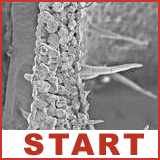Leaf epidermis |
||||||||||||
| ||||||||||||
Description: the upper surface (the adaxial side;1) and the lower side(the abaxialside; 2) of the leaf are delimited by a layer of epidermal cells (3; epi = upon, dermis = skin). The under epidermis is constituted by a joint layer of parenchyma cells that bear a thick cell wall but lack chloroplasts. In Coleus both epidermal layers carry hairs (4; trichomes); those at the abaxial side are clearly multicellular. Guard cells with stomata occur scattered in the under epidermis. The epidermis provides the leaf protection against dessication as well as physical and chemical impacts. There is a difference in anatomy between the layers below the epidermis up and down the leaf: the tissue against the under epidermis is contitued of roundish sponge parenchyma cells (5) that are separated by intercellular cavities (6). The upper epidermis is bordered by cylindrical cells, so-called palisade parenchyma cells (7). Sponge and palisade parenchyma cells together form the chlorenchym. Both cell types contain organelles involved in photosynthesis: the chloroplasts. (Detailed views of chloroplasts). The stomata, which are connected to the intercellular cavities, play a role in the exchange of gasses (carbon dioxide, oxygen and water as gas) between the chlorenchym inside the leaf and the atmosphere outside the plant. Further information on leaves can be found in a separate webseries.
Software development: Jeroen van Beurden
Web structure: Remco Aalbers
Text and images: Elisabeth Pierson and Huub Geurts
